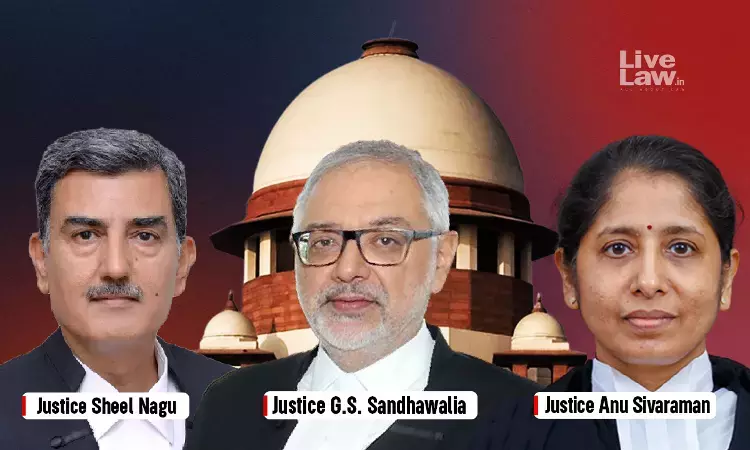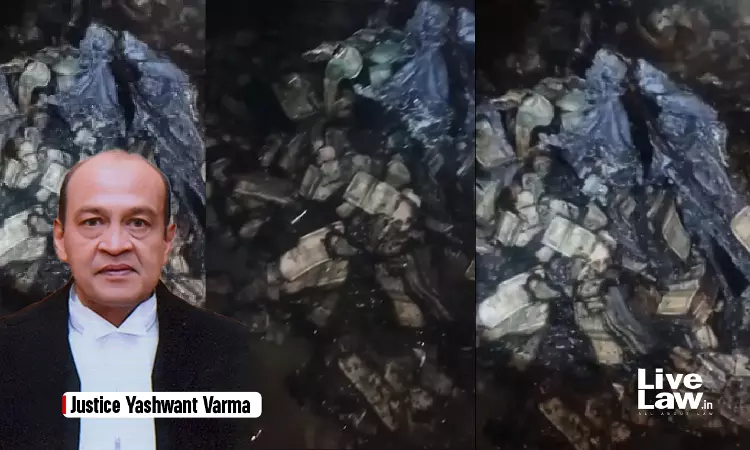- Home
- /
- Top Stories
- /
- Justice Yashwant Varma's Conduct...
Justice Yashwant Varma's Conduct After Fire Incident Unnatural, Says Inquiry Panel Rejecting Conspiracy Theories
LIVELAW NEWS NETWORK
20 Jun 2025 11:51 AM IST
The 3-judge in-house inquiry committee, which indicted Justice Yashwant Varma for keeping unaccounted cash in the storeroom annexed to his official bungalow, termed his conduct after the fire incident on March 14 - which led to the discovery of the currency notes - unnatural, leading to certain adverse inferences against him.The full report of the in-house committee, which came into the...
The 3-judge in-house inquiry committee, which indicted Justice Yashwant Varma for keeping unaccounted cash in the storeroom annexed to his official bungalow, termed his conduct after the fire incident on March 14 - which led to the discovery of the currency notes - unnatural, leading to certain adverse inferences against him.
The full report of the in-house committee, which came into the public domain following its publication by The Leaflet, concluded that there was sufficient substance in the allegations of misconduct against Justice Varma.
After examining 55 witnesses, including Justice Varma and his daughter, and electronic evidence in the form of videos and photographs taken by the members of the fire brigade, the committee held that cash was found in his official premises. Finding that the storeroom was within the “covert or active control of Justice Varma and his family members”, the committee held that the burden was upon him to explain the presence of cash. Since the judge could not discharge his burden by offering a plausible explanation, except giving a "flat denial or a bald plea of conspiracy", the committee found sufficient grounds to propose action against him.
The committee, consisting of Justice Sheel Nagu (CJ of P&H HC), Justice GS Sandhawalia (CJ of HP HC) and Justice Anu Sivaraman (judge of Karnataka High Court), was constituted by the then CJI Sanjiv Khanna on March 22, a day after reports about the discovery of cash notes surfaced.

The committee relied upon the evidence of several official witnesses who deposed about seeing the burning currency notes while undertaking the firefighting exercise on March 14. Significantly, in one of the videos, the committee noted that the voice of the Private Secretary of Justice Varma, Rajinder Singh Karki, was there, where he was heard calling another staff member of the judge, Md.Rahil. The committee also recorded that Karki admitted his voice.
From the call records, the committee found that Justice Varma was constantly communicating with his PS on the night of March 14 after the fire incident. An inference was made that the burnt cash/money was removed from the store room during the wee hours of March 15 after the fire brigade left.
Justice Varma's conduct unnatural
The committee opined that Justice Varma's conduct after his return from Bhopal on the evening of March 15, a day after the fire incident, was unnatural. It found it unusual that Justice Varma did not inspect the spot on his return. According to him, he visited the spot only when the Personal Private Secretary of the Delhi High Court Chief Justice reached there at 9 PM on March 15.
“A natural reaction of any person would be on arrival to first inspect the site to assess the damage, even if only house hold articles had been damaged and no person was hurt in the fire incident. Rather, if having done so firstly there would be no occasion for Justice Yashwant Varma to visit the site when the PPS had come forth to inspect the store room and he could have asked his Personal Secretary to facilitate the inspection by the PPS. This conduct on the part of Justice Yashwant Varma also is unnatural and defies all logic and leads the Committee to come to a conclusion that the correct picture has not been projected and necessarily an adverse inference has to be drawn against him.”
Justice Varma's conspiracy theory debunked
Justice Varma, in his defence, alleged that there was a conspiracy to frame him by planting the incriminating materials there. However, the committee did not take this at face value, observing that he had not named any specific person or had not specified any motive to frame him.
“The unnatural conduct of Justice Yashwant Varma has already been noticed above and the fact that if there was any conspiracy theory why he chose not to file any complaint with the police officials or bring it to the notice of the Chief Justice of the High Court or the Hon'ble the Chief Justice of India regarding the fact that there were planted stories regarding the burning of currency notes in the store room which is part of his house.”
Also, it was impossible for any outsider to plant the currency notes there, given that the place was under tight security and round-the-clock surveillance.
“Therefore, it is well nigh impossible for currency to be planted in the store room of a sitting Judge, which is being monitored by static 1+4 guard and a PSO stationed at the gate at all time, apart from the fact that the house abounds with a large number of old and trusted domestic servants with over six staff quarters.”
Further, if it was an act of arson, why did Justice Varma did not inspect the premises soon after his return, the committee wondered.
Justice Varma failed to preserve the CCTV visuals
In this context, the committee took note of Justice Varma's failure to preserve and retrieve the visuals from the CCTV cameras covering the storeroom. He told the committee that the cameras were found not to be working, and the hard disk was not retrievable. He took the defence that the data was lost since the hardware was not properly sealed.
The committee pointed out that it sealed the cameras and DVRs only on March 25, almost ten days after the incident. In the meantime, Justice Varma had the opportunity to secure the CCTV visuals.
“It was always open to Justice Varma as such to have got the data preserved, analyzed and scrutinized before this Committee had ordered the sealing, in case he had any plausible defence to further his conspiracy theory that the bags of currency were planted by someone else and area was accessible to one and all, not being part of the living area of the residential house. Thus, for a period of over ten days, the data was there to be preserved and could have been relied upon by him and help could have been taken to scrutinize the same to depict before this Committee that the store room was kept open and was open at the time of the fire incident and that he was not in station and not responsible for any material stored in the store room.”
The committee drew an adverse inference from the fact that Justice Varma did not secure the evidence, which could have been his best defence.
“The fact that no attempt was made by Justice Varma or any member of his household to report the incident to any quarters or to immediately secure the visuals from the CCTV cameras and make them available in support of his contentions, at least, when he was told on 17.03.2025 that there were photos and videos of burnt cash in his premises, renders his contentions totally unbelievable.”
Justice Varma's unquestioned acceptance of the transfer leads to adverse inference
The committee also referred to Justice Varma accepting the collegium's proposal to transfer him back to the Allahabad High Court from the Delhi High Court, without seeking any reasons.
“Another reason which weighs with us is post incident conduct that Justice Yashwant Varma knowing the inevitable, quietly accepted the proposal of transfer order which he received on 20.03.2025 (Ex.P-16) at 4.15 P.M. after finishing his judicial work from the office of Hon'ble the Chief Justice of India though he could have responded till 9.00 A.M. on 21.03.2025 as per the said proposal. The categorical acceptance on 20.03.2025 (Ex.P-17) immediately, without any demur and "respectfully accepting the decision of repatriation to Allahabad" would, in normal circumstances, only be done after discussion with family members at least and after an attempt to find out the reason for transfer, having served in Delhi High Court for the last three years. It is his categorical case that he has served diligently for a decade without any complaint. Thus, he would have liked to find out the reason for transfer.”
In the absence of any plausible explanation coming from Justice Varma or his family members, the Committee was left with no option, but to draw inferences against him.
“The factum of the burnt cash having been found in the store room was undeniably established and therefore, the burden shifted upon Justice Varma to account for the said cash/money by giving a plausible explanation which he failed to do except projecting a case of flat denial and raising a bald plea of conspiracy. Where presence of burnt cash in the store room is established, it is for Justice Varma to account for the same by either successfully raising a defence of planting of cash in the store room which he failed to do or proving the defence of conspirac theory by adducing evidence/material that the money/cash did not belong to him but to someone else by disclosing the identity of the real owner of the cash. Not having done so, Justice Varma cannot be helped and therefore, this Committee holds that the money/cash was found in the store room located within the premises of 30 Tughlak Crescent, New Delhi occupied by Justice Varma, the source of which could not be accounted for by Justice Varma.”
On May 8, the then CJI Sanjiv Khanna forwarded the report of the committee to the President and the Prime Minister on May 4 for further action against Justice Varma, after he refused to resign.
Also Read - Police Lapse In Seizing Cash Was 'Slipshod', But Doesn't Aid Justice Varma's Defence: Inquiry Committee



